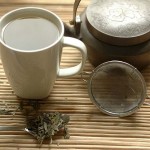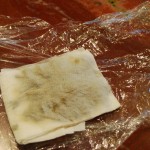How to Make…
Herbal Teas: Infusions and Decoctions
Don’t be intimitated by some of the fancy words that herbalists use in describing their preparations. The terms infusion and decoction simply describe the method used to prepare an herbal tea.
Infusion vs. Decoction
The term infusion simply means that you are not boiling the herb with your water. In other words, you will boil the water first and then poured that hot water over the herb. Then, you will let it steep for 5 to 10 minutes (or until desired strength) before using or straining. If you have made an herbal tea, even if using the kind that you buy at the store to drink, chances are you have already made an infusion. The herbs can be in a tea bag or not (just be sure to strain them first). The infusion method is genrally used when you are using cut or ground herbs for your teas.
The term decoction simply means that you are simmering the herb and water together (for about 20 minutes) to make your teas. The decoction method may be used when you are preparing your tea with barks, or roots (just be sure to mash the bark or root first). This method may also be used if the recipe calls for making a concentrated tea.
Not sure how much water or herbs to use? A good rule of thumb is to use 1 teaspoon of herb for each cup of water. Using more or less will determine the strength of tea.
Helpful Tips:
- It is best to use distilled water while making teas for herbal preparations. Also known as the “hungry water,” distilled water is more effective than other types of water in drawing out the healing properties from the herbs because it is free from impurities. Other types of waters have minerals in them, and these minerals hinder the water’s drawing power.
- It’s also advisable to use stainless steel or glass when boiling your herbal preparations. Stainless steel does not leech any of its properties into the water. However, products made from aluminum and iron do release their own properties into your water and will, thus, reduce the potenecy of your preparation. You may also be adding into your preparation harmful chemicals.
Simple Herbal Fomentations
Materials Needed:
- stainless steel pot
- herbs

- distilled water
- cotton cloth (cloth diapers work well or a white, unbleached dishcloth)
- plastic wrap (such as Saran wrap)
- ace bandage (optional, really for looks or if you want to hold the fomentation firmly in place)
How to Make:
To make a simple fomentation, simply make your herbal tea first using your pot, herbs, and distilled water. Dip the cotton cloth into the tea and lightly squeeze. Wrap or place the cotton cloth that has been soaked with your herbal tea directly onto the affected area. Use plastic wrap to hold the cotton cloth in place (may also use a snug-fitting, t-shirt). The plastic wrap will ensure that the herbs will stay on the skin instead of getting soaked up into your clothes or evaporating too quickly. Wrap with an ace bandage if you need to “cover it up” for work or if you just feel weird walking around with plastic wrap wrapped on you. The ace bandage would be wrapped on top of the plastic wrap; it’s not used in place of it.
Helpful Tips:
- Fomentations may be used all over the body. Examples can be around your writsts, legs, chest, feet, throat, etc
- If you are using a fomentation around your throat a good way to hide the plastic wrap would be to wear a turtleneck or a scarf!
- Turn the fomentation into an effective “icy-hot” treament by alternating the use of heat and cold to the affected area on top of your fomentation. A good rule of thumb is to first apply heat to the area for 12 minutes using either a hot water bottle or a heating pad. Then apply cold using an ice-pack for 4 minutes. Heat and cold can be applied for more or less time depending on the comfort level of the patient.
Your Fomentations Safe for Your Little One
Helpful Tip:

Because infant and toddler skin is still very delicate, you will not want to apply your fomentations (or certain ointments with harsh herbs such as cayenne) directly to their skin. To protect the skin, first apply a small layer of olive oil to the affected area before directly applying your fomentation or ointment. The olive oil will provide an adequate protective coat for your little one. Also be sure that your herbs or cloth are not too hot in temperature. You are not trying to scald your little patient!
